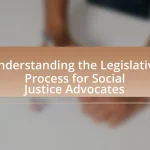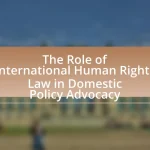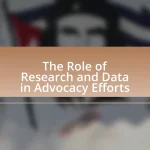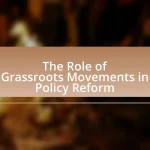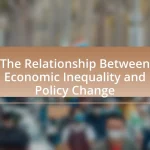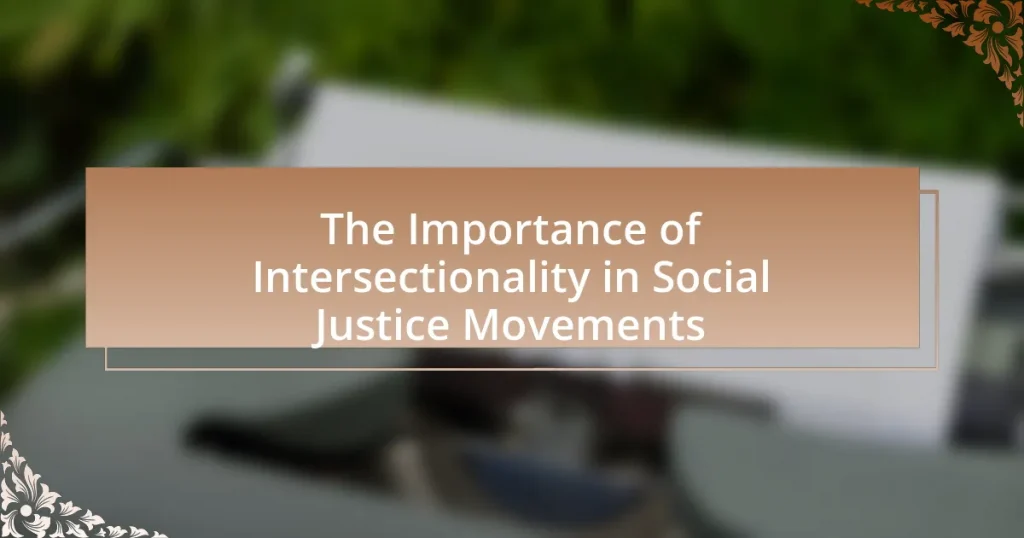Intersectionality in social justice movements is a framework that examines how various social identities—such as race, gender, sexuality, class, and ability—intersect to create overlapping systems of discrimination. Introduced by Kimberlé Crenshaw in 1989, this concept emphasizes that individuals experience oppression in multifaceted ways, necessitating a nuanced approach to social justice that includes the voices of marginalized groups. The article explores the emergence of intersectionality in social justice discourse, its distinction from traditional frameworks, and its significance in understanding social inequalities. It also discusses the practical steps activists can take to implement intersectionality in their work, the challenges faced in applying intersectional approaches, and the benefits of fostering intersectional alliances in activism.
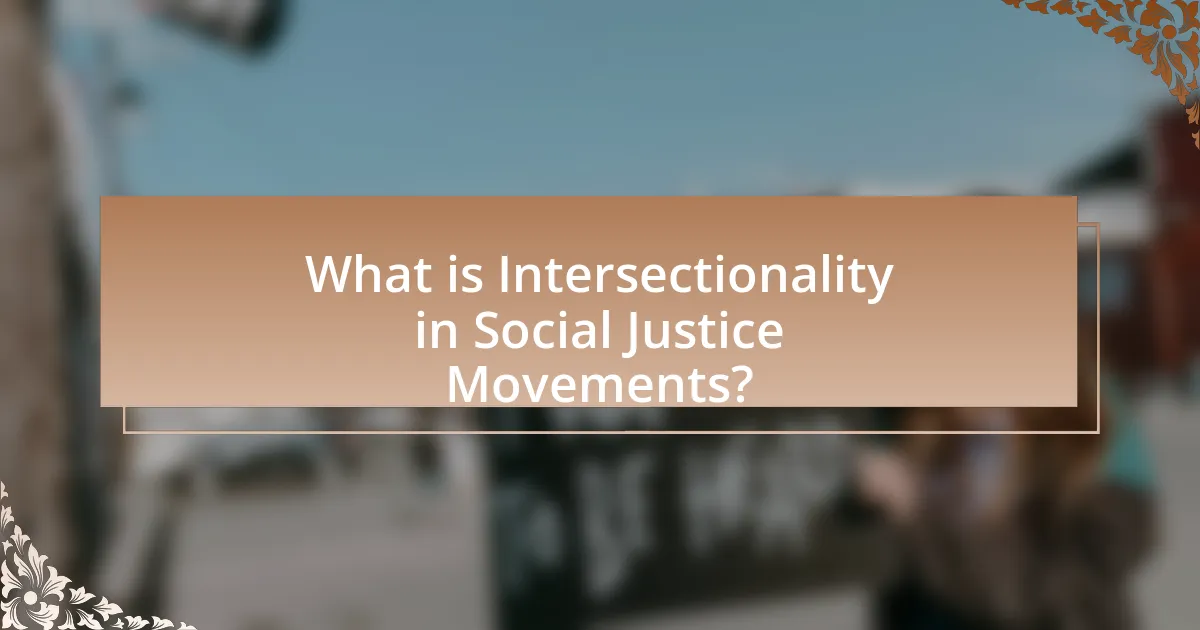
What is Intersectionality in Social Justice Movements?
Intersectionality in social justice movements refers to the framework that examines how various social identities—such as race, gender, sexuality, class, and ability—intersect and create overlapping systems of discrimination or disadvantage. This concept, introduced by Kimberlé Crenshaw in 1989, highlights that individuals experience oppression in multifaceted ways, which cannot be understood by looking at social categories in isolation. For instance, a Black woman may face both racial and gender discrimination simultaneously, which shapes her experiences differently than those of a white woman or a Black man. This understanding is crucial for developing inclusive strategies that address the unique challenges faced by marginalized groups within social justice movements.
How did the concept of intersectionality emerge in social justice discourse?
The concept of intersectionality emerged in social justice discourse primarily through the work of Kimberlé Crenshaw in the late 1980s. Crenshaw introduced the term to highlight how various forms of social stratification, such as race, gender, and class, intersect and create unique experiences of oppression. Her seminal paper, “Mapping the Margins: Intersectionality, Identity Politics, and Violence against Women of Color,” published in 1991, provided a framework for understanding how overlapping identities can lead to compounded discrimination. This framework has since been widely adopted in social justice movements to advocate for a more nuanced approach to addressing inequality and to ensure that the voices of marginalized groups are included in the discourse.
What key events or figures contributed to the development of intersectionality?
The development of intersectionality was significantly influenced by key figures such as Kimberlé Crenshaw, who coined the term in 1989, and events like the Combahee River Collective’s statement in 1977, which highlighted the interconnectedness of race, gender, and class. Kimberlé Crenshaw’s work emphasized how traditional feminist and anti-racist movements often overlooked the unique experiences of Black women, thereby establishing the framework of intersectionality to address these overlapping identities. The Combahee River Collective, a group of Black feminists, articulated the necessity of recognizing multiple social identities and their impact on oppression, laying foundational ideas for intersectional analysis. These contributions have been pivotal in shaping contemporary social justice movements by advocating for a more nuanced understanding of how various forms of discrimination intersect.
How does intersectionality differ from traditional social justice frameworks?
Intersectionality differs from traditional social justice frameworks by emphasizing the interconnected nature of social categorizations such as race, gender, and class, which create overlapping systems of discrimination or disadvantage. Traditional social justice frameworks often address issues in isolation, focusing on single-axis identities, whereas intersectionality recognizes that individuals experience multiple, simultaneous forms of oppression. For example, Kimberlé Crenshaw, who coined the term “intersectionality,” illustrated how Black women face unique challenges that are not fully understood when examining race or gender separately. This approach allows for a more nuanced understanding of social inequalities and advocates for policies that address the complexities of individuals’ lived experiences.
Why is intersectionality crucial for understanding social inequalities?
Intersectionality is crucial for understanding social inequalities because it reveals how various social identities, such as race, gender, class, and sexuality, intersect to create unique experiences of oppression and privilege. This framework allows for a comprehensive analysis of how systemic inequalities are not experienced uniformly; for example, Black women face discrimination that is distinct from that experienced by white women or Black men. Research by Kimberlé Crenshaw, who coined the term “intersectionality,” highlights that traditional approaches to social justice often overlook these overlapping identities, leading to inadequate solutions that fail to address the specific needs of marginalized groups. By recognizing the complexity of social identities, intersectionality provides a more nuanced understanding of social inequalities, enabling more effective advocacy and policy-making.
What are the various dimensions of identity that intersectionality considers?
Intersectionality considers various dimensions of identity, including race, gender, sexuality, class, ability, age, and ethnicity. These dimensions interact to shape individual experiences and social positions, highlighting how overlapping identities can lead to unique forms of discrimination or privilege. For example, a Black woman may face both racial and gender discrimination, which cannot be fully understood by examining race or gender in isolation. This framework is supported by Kimberlé Crenshaw’s foundational work on intersectionality, which emphasizes the need to analyze social issues through the lens of multiple, intersecting identities to address systemic inequalities effectively.
How do intersecting identities impact individuals’ experiences of oppression?
Intersecting identities significantly impact individuals’ experiences of oppression by compounding the effects of discrimination based on race, gender, sexuality, class, and other social categories. For example, a Black woman may face both racial and gender discrimination, leading to unique challenges that differ from those experienced by a white woman or a Black man. Research by Kimberlé Crenshaw, who coined the term “intersectionality,” highlights how legal frameworks often fail to address the specific needs of individuals with multiple marginalized identities, resulting in inadequate protections and support. This compounded oppression can manifest in various areas, including employment, healthcare, and criminal justice, where individuals with intersecting identities often face harsher treatment and fewer opportunities.
What role does intersectionality play in contemporary social justice movements?
Intersectionality plays a crucial role in contemporary social justice movements by highlighting how various forms of discrimination and oppression intersect and compound individual experiences. This framework allows activists to understand that issues such as race, gender, sexuality, and class do not exist in isolation but interact to create unique challenges for marginalized groups. For example, the Black Lives Matter movement incorporates intersectional perspectives by addressing not only police violence against Black individuals but also how this violence disproportionately affects Black women and LGBTQ+ individuals. Research by Kimberlé Crenshaw, who coined the term “intersectionality,” emphasizes that failing to consider these overlapping identities can lead to inadequate responses to social injustices. Thus, intersectionality is essential for creating inclusive strategies that effectively address the diverse needs of all community members within social justice initiatives.
How do activists incorporate intersectionality into their strategies and goals?
Activists incorporate intersectionality into their strategies and goals by recognizing and addressing the interconnected nature of social categorizations such as race, gender, class, and sexuality. This approach allows them to develop more inclusive policies and practices that reflect the diverse experiences of marginalized groups. For instance, the Black Lives Matter movement emphasizes the unique challenges faced by Black women and LGBTQ+ individuals, ensuring that their voices are included in discussions about racial justice. Research by Crenshaw (1989) highlights how traditional feminist and anti-racist movements often overlook the specific needs of individuals at the intersection of multiple identities, demonstrating the necessity of an intersectional framework in activism.
What challenges do social justice movements face when applying intersectional approaches?
Social justice movements face significant challenges when applying intersectional approaches, primarily due to the complexity of addressing multiple, overlapping identities and systemic inequalities. This complexity can lead to difficulties in coalition-building, as diverse groups may have conflicting priorities or experiences that complicate unified action. Additionally, there is often a lack of resources and understanding among activists and organizations about how to effectively implement intersectionality in their strategies, which can result in superficial engagement rather than meaningful change. Research by Crenshaw (1989) highlights that without a nuanced understanding of how various forms of discrimination intersect, movements risk marginalizing the very groups they aim to support, ultimately undermining their goals for equity and justice.
How can intersectionality enhance solidarity among diverse groups?
Intersectionality enhances solidarity among diverse groups by recognizing and addressing the interconnected nature of social identities and systemic inequalities. This framework allows individuals from various backgrounds to understand how their unique experiences of oppression and privilege intersect, fostering empathy and collaboration. For instance, the 2015 Black Lives Matter movement highlighted the importance of including voices from LGBTQ+ communities, women, and other marginalized groups, demonstrating that collective action is more effective when it acknowledges diverse experiences. By embracing intersectionality, social justice movements can build stronger coalitions that advocate for comprehensive solutions, ultimately leading to more inclusive and equitable outcomes for all involved.
What are the benefits of fostering intersectional alliances in activism?
Fostering intersectional alliances in activism enhances the effectiveness and inclusivity of social movements. These alliances bring together diverse perspectives, allowing for a more comprehensive understanding of social issues that affect various marginalized groups. Research indicates that movements that embrace intersectionality can mobilize broader coalitions, leading to increased visibility and support for underrepresented voices. For instance, the Women’s March in 2017 exemplified how intersectional alliances can unite different demographics, amplifying the call for social justice across multiple fronts, including race, gender, and class. This collaborative approach not only strengthens advocacy efforts but also fosters solidarity, creating a more unified front against systemic oppression.
How can intersectionality help address the needs of marginalized communities?
Intersectionality can help address the needs of marginalized communities by recognizing and analyzing the interconnected nature of social categorizations such as race, gender, class, and sexuality. This framework allows for a more nuanced understanding of how various forms of discrimination and privilege overlap, leading to unique experiences of oppression. For instance, research by Kimberlé Crenshaw, who coined the term “intersectionality,” highlights how Black women face discrimination that is not fully addressed by policies focused solely on race or gender, as their experiences are shaped by both identities simultaneously. By applying an intersectional lens, social justice movements can create more inclusive policies and practices that specifically target the compounded disadvantages faced by individuals at the intersections of multiple marginalized identities.
What practical steps can activists take to implement intersectionality in their work?
Activists can implement intersectionality in their work by actively engaging with diverse communities and incorporating their unique experiences into advocacy efforts. This involves conducting thorough research to understand the specific needs and challenges faced by marginalized groups, such as women of color, LGBTQ+ individuals, and people with disabilities. For instance, the 2017 Women’s March highlighted the importance of intersectionality by including voices from various identities, demonstrating that a unified movement must address multiple forms of oppression. Additionally, activists should prioritize coalition-building with organizations that represent different social justice issues, ensuring that all perspectives are included in decision-making processes. This approach not only strengthens the movement but also fosters solidarity among various groups, as evidenced by the collaborative efforts seen in campaigns like Black Lives Matter, which emphasizes the interconnectedness of racial justice and other social issues.
How can organizations assess their commitment to intersectional practices?
Organizations can assess their commitment to intersectional practices by conducting comprehensive audits of their policies, programs, and outcomes to identify how they address the diverse needs of marginalized groups. This assessment can include collecting disaggregated data on race, gender, sexual orientation, and other identity factors to evaluate the effectiveness of their initiatives. Research indicates that organizations that implement intersectional frameworks are more likely to achieve equitable outcomes, as evidenced by studies showing that inclusive practices lead to improved engagement and satisfaction among diverse populations.
What resources are available for learning about intersectionality in activism?
Books, articles, and online courses are key resources for learning about intersectionality in activism. Notable books include “Intersectionality” by Kimberlé Crenshaw, which lays the foundational theory of intersectionality, and “Sister Outsider” by Audre Lorde, which explores the complexities of identity and oppression. Academic journals such as “Signs: Journal of Women in Culture and Society” publish peer-reviewed articles on intersectionality and its implications in activism. Online platforms like Coursera and edX offer courses on social justice that include modules on intersectionality, providing structured learning opportunities. These resources collectively enhance understanding of how various social identities intersect and influence activism.
